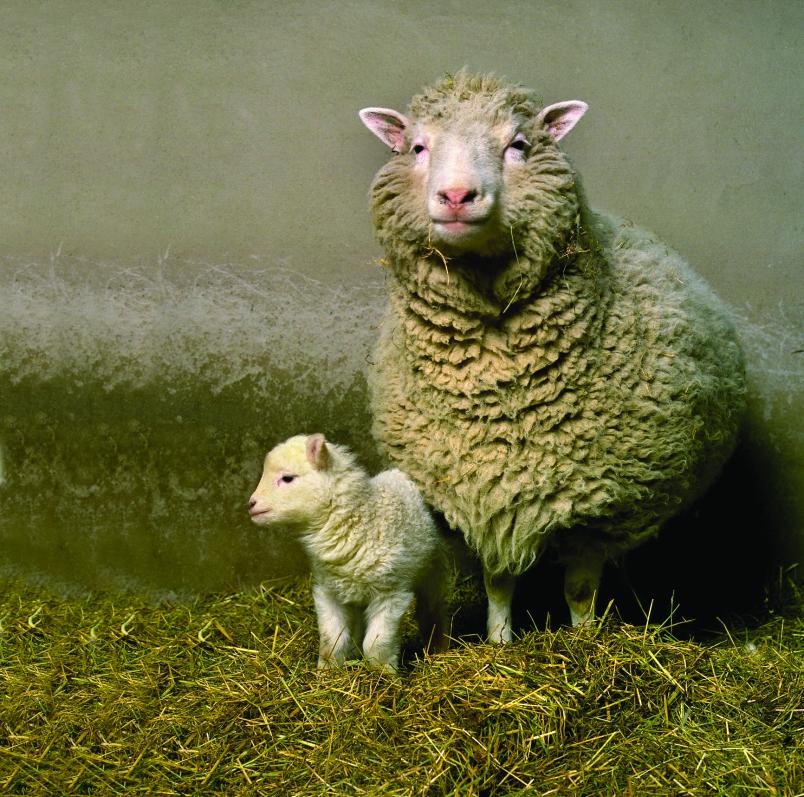
History of science
How Dolly came about
In retrospective, it always seems as if gaining new knowledge had been a purposeful process. Christina Brandt can list many examples that prove that this is not true; one of them is the history of cloning.
When cloned sheep Dolly was born in 1996, cloning was the talk of the town. In public, it appeared as if the birth of the mammal clone celebrity was the icing on the cake, following the groundwork researchers had been laying prepared for decades before they finally reached their preliminary goal. Society speculated about the next steps; it seemed possible that human clones would emerge one day.

Prof Dr Christina Brandt has analysed in detail how the cloned sheep had come about. The historian of science and member of the Mercator Research Group “Spaces of Anthropological Knowledge” analyses how knowledge is generated in the field of life sciences. Her sources include academic publications, estates of deceased researchers, laboratory notes, interviews with contemporaries, newspaper articles, lectures and congresses. Like a detective, she assumes the role of the researchers, dissects their networks, and attempts to comprehend each single detail of their experiments. “This is the only way to create a precise picture,” she says. “If I were merely to read the publications, too many steps and conditions of the process would remain obscured.”
Apples were the first clones
The term “clone” can be traced back to 1903. It cropped up in plant breeding and referred to the asexual generation of plants. “Apples were the first clones,” she says. “The goal was to achieve economic benefits, create a new industry.” The first patents for cloned crop plants were filed in the USA in the 1930s.

A long time later, in the 1950s, the term clone was picked up by embryologists. They studied a question that dates back much longer, namely to the 1880s and 1890s: does the nucleus lose information during embryonic development? In order to answer this question, researchers in the USA and the UK developed a new technique. John Gurdon, who, together with Shin’ya Yamanaka, was the winner of the Nobel Prize for Medicine in 2012, switched off the nucleus in the egg cells of clawed frogs and replaced it with the (differentiated) nucleus of a different frog cell. In spite of that, the embryo developed in the normal way. The frog was cloned.
This is how, in the 1960s, proof was provided that the nucleus does in fact not lose its information; rather, it maintains them throughout the frog’s entire lifetime. “That was basic research,” points out Christina Brandt. “The scientists involved in the project did not aim at cloning identical individuals.”
Other expert groups developed visions
While the embryologist community still debated about the results of John Gurdon’s research – their status was not yet clear, because the original nucleus had been switched off rather than removed – other scientists picked up the knowledge of the new technology and began to develop far-reaching future visions. The knowledge that cloning was possible seeped into society; the image of a new bio-power solidified. In the 1960s, the status of biology changed dramatically in the public perception: molecular biology was increasingly regarded as the leading science of tomorrow.
“Outside the close circle of experts, people lack the awareness of how complex this kind of research really is,” explains Christina Brandt. “Moreover, the 1960s were an era of optimistic faith in progress. In the USA in particular, people believed in a dynamics of technological forces. It went along the lines of: like it or not, cloning will become reality.” In Germany, on the other hand, the people regarded it more critically. Here, memories of the NS ideology came up.
Knowledge circulates
In the meantime, embryologists turned their back on cloning technology and focused on the questions that the results of John Gurdon’s research had raised: they concluded that, if the nucleus never changes its information during lifetime, (as yet unknown) elements with regulatory functions had to be located in the surrounding cytoplasm. Those elements determine which genetic information is read and implemented at which point during embryonic development.
Meanwhile, knowledge of cloning circulated. In the 1970s and 1980s, a widespread public and political debate about cloning emerged. The researchers who had developed cloning disassociated themselves from it: they were interested in the technology, not in the cloning of humans.
30-year-old technology results in Dolly
Accordingly, embryologists interested in general problems didn’t have much to do with the cloned sheep Dolly, the first cloned mammal in the 1990s. Scientists interested in practical application used the 30-year-old technology with the aim of applying it for agricultural purposes: by generating individuals identical to particularly successful farm animals, or by utilising cloning technology as a tool for the manufacture of genetically modified organisms.

In many ways, the history of cloning is characteristic of the history of science, as Christina Brandt elaborates. “The generation of knowledge is extremely local, because the know-how is held by individual researchers or research groups, and large expensive equipment is installed in only a few locations. Technological advancement is accomplished once disciplinary barriers are transcended, and it is not a straightforward process. The dynamics of the research process is boosted by the oscillation between scientific curiosity and technological applicability. The visionaries in the field of cloning were in fact not the embryologists who had developed the techniques.

The generation of new knowledge is often completely unpredictable.
Christina Brandt
One characteristic aspect is also the fact that existing technologies are picked up and implemented in applications a long time after they were first created. Some areas of research that at some point were considered downright esoteric will later experience a boom.
“The generation of new knowledge is often completely unpredictable. Accordingly, this is also an ethical problem. We can never be sure for which purpose something that had been developed with a specific goal in mind might one day be used,” concludes Christina Brandt. Countless factors and accidents affect the generation of knowledge. “Our certainties of today may be revised or become obsolete in a few decades. The same applies to major hopes and fears of society, which are vehemently negotiated in an area of research at some point. In the course of history, they often turn out to be irrelevant, because a new ethical controversy in a completely different area suddenly materialises that had not been previously discussed.”